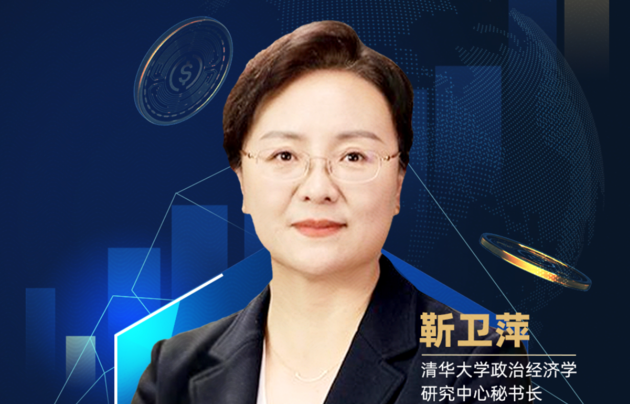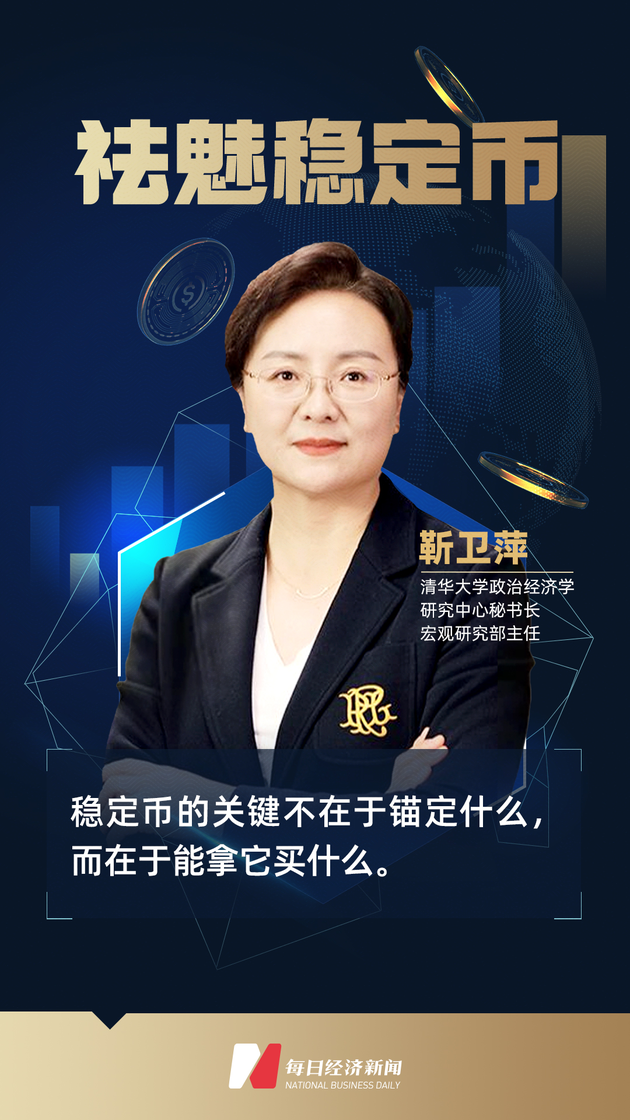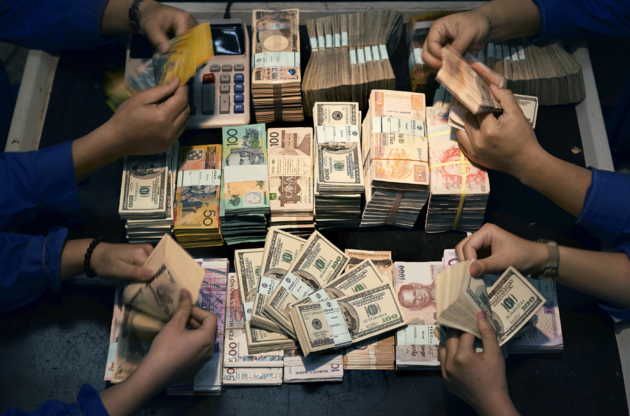
Financial giants from JPMorgan to Citigroup are accelerating their stablecoin issuance plans, while companies like Amazon and Walmart are reportedly preparing their own platform-specific stablecoins.
With the "Geniuses Act" now in effect, stablecoins are no longer a fringe concept in the cryptocurrency industry but are becoming a core digital financial infrastructure that major institutions actively seek to control. The questions of who can issue coins, what types of coins can be issued, and what can be purchased with them are emerging as critical issues poised to reshape the global financial order.
In an exclusive interview with National Business Daily (NBD), Jin Weiping, Secretary-General of Political Economy Research Center and Director of Macro Research Department at Tsinghua University, stated that the core competition for stablecoins lies not in which fiat currency they are pegged to, but in the presence of real, credible transaction scenarios backing them.
"People will only use them if they can buy cars, assets, or services with them," she emphasized. "The current stablecoin race is a multi-faceted game involving technology, financial regulations, and the right to control value flow. Whoever builds a viable application network will hold the future of financial initiative."

Stablecoins: Trump's New Tool for the "Triffin Dilemma"
NBD: The U.S. recently signed stablecoin-related policies and regulations. Why now?
Jin Weiping: Stablecoins emerged a decade ago as a derivative of virtual currencies, gaining some attention but largely operating outside systematic regulatory frameworks. The virtual currency market at the time was chaotic and lacked regulation. Stablecoins, however, offered clear advantages; their transactional convenience perfectly aligns with today's needs, and there's an international demand for such payment-friendly virtual currencies.
From the perspective of the U.S. government, stablecoins now hold significant value. The Trump administration has made several attempts to address the U.S. debt issue: initially proposing the so-called Mar-a-Lago Accord for 50-to-100-year ultra-long-term Treasury bonds, which garnered no interest; followed by the "Pennsylvania Plan," aiming for domestic banks to absorb U.S. debt. Stablecoins represent his third move: by attracting U.S. dollars or short-term funds from the market, they can substitute traditional Treasury financing.
Specifically, stablecoins are exchanged for U.S. dollars, and these acquired dollars are then used to purchase U.S. cash, notice deposits, U.S. Treasury bills maturing within 93 days, repurchase agreements, reverse repurchase agreements, and money market funds that invest solely in these assets. Since stablecoin holders might need to redeem dollars at any time, long-term Treasury bonds cannot be held. This operational structure conveniently matches the Trump administration's financing gap.
NBD: Aside from fiscal motivations, does the U.S. have other considerations, such as political factors?
Jin Weiping: Yes. During his first term, Trump strongly opposed virtual currencies, calling them a scam. However, due to interference, the government faced repeated fiscal crises. During the 2024 election campaign, he received substantial financial support from cryptocurrency companies, with his family even directly participating in coin issuance, and Elon Musk providing guidance in the relevant fields. Through this process, Trump discovered the profit potential of this sector, leading to a shift in his stance. He made "making America a global virtual currency center" a campaign promise, essentially a political return to his benefactors.
A deeper motivation is Trump's attempt to use dollar-pegged stablecoins to resolve the "Triffin Dilemma," a structural contradiction where the U.S., to maintain the dollar's international dominance, must continuously export dollars, conflicting with its goals of maintaining domestic trade balance and fiscal stability. Dollar-pegged stablecoins, however, can maintain the dollar's global dominance while simultaneously fostering trade balance and manufacturing repatriation. This, in a way, extends the dollar's global financial function and helps repatriate domestic capital, serving as a form of institutional innovation.
However, it's worth noting that this initiative may not solve the problem of U.S. manufacturing hollowing out as Trump hopes; instead, it might exacerbate the U.S. tendency towards "de-industrialization and financialization." After dollar repatriation, U.S. domestic capital may not flow into the real manufacturing sector, given the long return cycles in manufacturing, potentially fueling speculative impulses in virtual currency trading. Thus, dollar-pegged stablecoins might address short-term U.S. debt issues but struggle to cure long-term structural problems.
Stablecoin Issuers' Inherent Impulse to "Over-issue"

Photo/VCG
NBD: Can you discuss the risks associated with dollar-pegged stablecoins?
Jin Weiping: Stablecoin issuers have an inherent impulse to over-issue. Although they ostensibly claim to be pegged to the dollar with equal exchange rates, stablecoin issuing institutions essentially possess "quasi-commercial bank" powers to issue currency. When users inject dollars, institutions issue stablecoins, and in this process, they have an incentive for over-issuance, gambling that users won't massively redeem stablecoins for dollars.
NBD: Wouldn't over-issuance violate regulatory provisions?
Jin Weiping: This is precisely the core of the problem. Despite the Trump administration introducing relevant regulatory bills, the risk of "self-dealing" is prevalent. If issuing institutions anticipate that users won't demand mass redemptions of dollars, they might over-issue stablecoins to gain additional liquidity, enabling "money to make money." Once these over-issued stablecoins enter gray or even black markets, they can generate additional financial returns for the institutions. In recent years, the continuous relaxation of U.S. commercial bank regulation has significantly increased the probability of such self-dealing, ultimately threatening financial system stability.
For smaller economies, a lack of sufficient risk awareness could lead to their monetary issuance rights being usurped by stablecoin issuing institutions.
NBD: So, this isn't just a technical issue, but also a struggle for financial sovereignty?
Jin Weiping: Exactly. The U.S. aims to extend the dollar's function through stablecoins to maintain its global financial dominance. The European Union fears stablecoins will weaken central bank power, and the Bank for International Settlements even refuses to acknowledge their "currency" attribute. Behind this lies a contest for financial dominance among different players.
The Key to Stablecoins: Not What They Anchor, But What They Can Buy

Photo/VCG
NBD: Will there be a competitive landscape among different stablecoins in the future?
Jin Weiping: Yes, there will. Almost anyone meeting the qualifications can issue stablecoins. For instance, Nvidia and Elon Musk have expressed interest, for a simple reason: stablecoin transactions are convenient and have low fees, making them potentially the most suitable transaction method for the AI era.
From the perspective of great power competition, the key to stablecoin competition is not "who issues the coin," but "who sets the rules." Whoever controls rule-making, possessing stronger algorithmic capabilities and computational infrastructure, will be able to build a dominant global financial network. To put it directly, the flexibility of rules, the efficiency of algorithms, and the stability of systems will directly determine who can more efficiently attract global hot money and embed their stablecoins into real transaction scenarios, becoming the default "infrastructure" for digital finance.
As for which fiat currency a stablecoin is pegged to, that's a secondary consideration. The crucial factor is who can dominate the rules and the flow of value, which directly determines who will ultimately gain greater benefits from the global financial system. When a system can more efficiently generate returns, it naturally creates a powerful attraction, similar to how the U.S. stock market, even with high valuations, continues to attract global investors.
For example, the future trend for stablecoins is Real World Assets (RWA). GF Securities (Hong Kong), in partnership with HashKey Chain, launched Hong Kong's first tokenized security, "GF Token," which can be subscribed and redeemed daily. If the returns are stable and the credit reliable, it's entirely possible to attract users to invest using relevant stablecoins. Other RWAs and Real Data Assets (RDA) will increasingly appear in our daily lives.


 川公网安备 51019002001991号
川公网安备 51019002001991号





